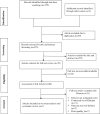Adverse birth outcome and associated factors among diabetic pregnant women in Ethiopia: Systematic review and meta-analysis
- PMID: 33170888
- PMCID: PMC7654793
- DOI: 10.1371/journal.pone.0241811
Adverse birth outcome and associated factors among diabetic pregnant women in Ethiopia: Systematic review and meta-analysis
Erratum in
-
Correction: Adverse birth outcome and associated factors among diabetic pregnant women in Ethiopia: Systematic review and meta-analysis.PLoS One. 2021 Mar 30;16(3):e0249652. doi: 10.1371/journal.pone.0249652. eCollection 2021. PLoS One. 2021. PMID: 33784354 Free PMC article.
Abstract
Background: The magnitude of adverse birth outcome among diabetic pregnant women is high in low-and-middle income countries, like Ethiopia. Precise epidemiological evidence is necessary to plan, evaluate and improve effective preventive measures. This systematic review and meta-analysis is the first to estimate the pooled prevalence of adverse birth outcome and associated factors among diabetic pregnant women in Ethiopia.
Methods: PubMed, Cochrane Library, Google Scholar, SCOPUS, Web of Science and PsycINFO, and article found in University online repository were accessed. Observational studies such as cross-sectional, case-control and prospective cohort reported using English language was involved. I2 statistic was used to check heterogeneity. Egger's test and funnel plot were used to measure publication bias. Weighted inverse variance random effects model was also performed.
Results: Seven studies with 1,225 study participants were retrieved to estimate the pooled prevalence of adverse birth outcome and associated factors. The pooled prevalence of adverse birth outcome among diabetic pregnant women was 5.3% [95% CI; 1.61, 17.41]. Fasting blood glucose level above 100 mg/dl [Adjusted Odds ratio (AOR) = 10.51; 95% Confidence Interval (CI) = 5.90, 15.12], two hour post prandial glucose level above 120 mg/dl [AOR = 8.77; 95% CI = 4.51, 13.03], gestational age <37 completed week [AOR = 9.76; 95% CI = 5.29, 14.23], no ANC follow-up [AOR = 10.78; 95% CI = 6.12, 15.44], history of previous adverse outcomes [AOR = 3.47; 95% CI = 1.04, 5.90], maternal age < 30 years [AOR = 3.47; 95% CI = 1.04, 5.90], and illiteracy [AOR = 2.89; 95% CI = 0.81,4.97)] were associated factors of adverse birth outcome.
Conclusions: The pooled prevalence of adverse birth outcomes among diabetic pregnant women in Ethiopia was high. Child born from mothers who were illiterate, maternal age < 30 years, gestational age < 37 completed weeks, history of previous adverse birth outcomes and no ANC follow-up increased the risk of adverse birth outcome.
Trial registration: It is registered in PROSPERO data base: (PROSPERO 2020: CRD42020167734).
Conflict of interest statement
The authors have declared that no competing interests exist.
Figures




References
-
- I.D.F., Diabetes facts & figures https://www.idf.org/aboutdiabetes/what-is-diabetes/facts-figures.html Accessed date 6/19/2020. 12/02/2020.
-
- Evers I.M., de Valk H.W., and Visser G.H., Risk of complications of pregnancy in women with type 1 diabetes: nationwide prospective study in the Netherlands. Bmj, 2004. 328(7445): p. 915 10.1136/bmj.38043.583160.EE - DOI - PMC - PubMed
Publication types
MeSH terms
LinkOut - more resources
Full Text Sources
Medical

